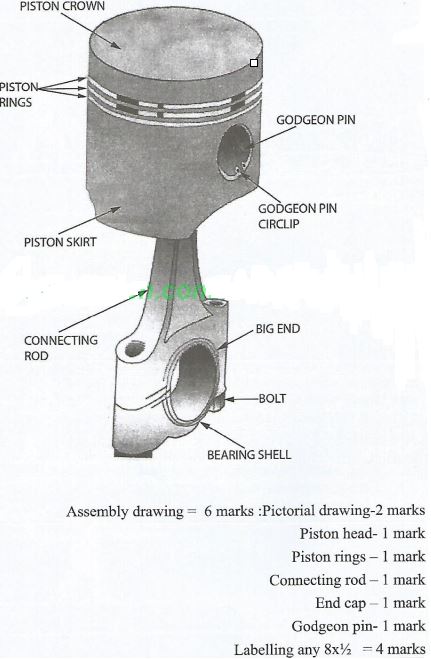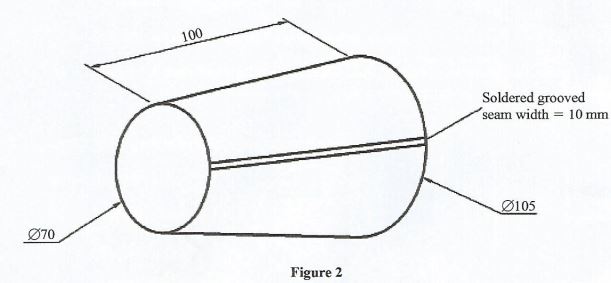STATION 1
INSTRUCTIONS
Figure 1 shows an aircraft engine assembly.
In the spaces provided (10 marks)
- Sketch the pictorial assembly of the parts labelled A.
- Label eight parts of the assembly in (a)
STATION 2
INSTRUCTIONS
Using the tools and materials provided, fabricate the aircraft engine exhaust duct as shown in Figure 2 (10 marks)
Let the examiner check your work
STATION 3
INSTRUCTIONS
- Identify the parts of the crankshaft labelled red, blue, green and yellow.
Red
Blue
Green
Yellow (2 marks) - Measure and record the following:
- Inside diameter of part painted red.
- Diameter of part painted black
- The angle of the part painted white
- Depth of the end painted white
- The size of threads on the threaded part
- Size of the con bearing...... (6 marks)
- State four maintenance checks that must be carried out to ensure serviceability of the part painted yellow.
STATION 4
INSTRUCTIONS
Using the tools and materials provided, carry out each of the following task then complete Table 1:
- Apply sample 1 on the part labelled 6.
Carefully look for evidence of letters showing through the white paint then record the following in Table 1:- The hiding results
- Most appropriate area of use on an aircraft after repair
Clean and dry the patch plate using the thinner, brush and rug provided.
- Repeat step (a) for each of the samples 2, 3, 4 and 5 and complete Table 1.
(10 marks)Sample Hiding results Appropriate area of use on an aircraft 1. 2. 3. 4. 5.
STATION 5
INSTRUCTIONS
Using the tools and battery provided perform each of the flowing tasks:
Page
- Identify the tool labelled A
Tool A (1⁄2 mark) - Measure and record the voltage across positive and negative terminals of the battery labelled B Voltage (1⁄2 mark)
- Measure and record the specific gravity then determine the condition and state the corrective procedure for results obtained on each of the cells as marked C, D, E, F, G and H on various batteries.
Complete Table 2.
Table 2
(9 marks)Cell Specific gravity Condition Corrective procedure C D E F G H
STATION 6
- Study the set up provided and carry out each of the following:
- Record the reading of the spring balance without load.
Reading - Hook the spring balance to the set up and select switch 1 to ON position.
Record the observation and reading on the spring balance.
Observation
Reading. - Select switch 2 to ON position.
Record the observation and reading on the spring balance.
Observation
Reading.. - Select switch 3 to ON position
Record the observation and reading on the spring balance
Observation
Reading. (3½marks)
- Record the reading of the spring balance without load.
- State four reasons behind the observations in (a) (i) to (iv).
Reasons (2 marks) - State the Law and the Principle behind your observations.
Law
Principle (2 marks) - Identify one aircraft system which utilises this Principle. (1 mark)
- Relate your observations at each switch position in (a) to an aircraft operation. (1½ marks)
STATION 7
INSTRUCTIONS
Using the tools and materials provided, carry out each of the following tasks:
-
- Suck the water from the container provided using the syringe marked J, gradually and record your observation.
Observation - Repeat step (i) using the syringe marked K and record your observation.
Observation - State the reasons behind your observations in (i) and (ii).
Reasons - Relate the observations in (i) to two aircraft systems.
Aircraft systems (4 marks)
- Suck the water from the container provided using the syringe marked J, gradually and record your observation.
-
- Hold syringe J above the water level and gradually discharge the water into the container provided. Record your observations.
- Repeat step (i) using the syringe marked K.
Record the observations. - Give the cause of the observations in (ii) above.
- State one application of the Principle in (b) (i) to an aircraft engine. (2 marks)
-
- Suck the water from the container using the syringe marked L. Hold it above the water level. Record the observations.
- Explain the reason for the observation.
- State two applications of the observations in c (i) to aircraft systems. (4 marks)
STATION 8
INSTRUCTIONS
Using the tools, equipment and parts provided, demonstrate to the examiner the procedure of replacing the piston rings. (10 marks)
Let the examiner check your work.
STATION 9
INSTRUCTIONS
Using the model provided, demonstrate to the examiner the procedure of performing mouth to mouth and mouth to nose respiration to a person who has suffered from electrical shock resulting in respiratory stoppage in a workshop. (10 marks)
STATION 10
INSTRUCTIONS
Using the materials and the tools provided, carry out each of the following tasks and complete Table 3.
-
- Hold the material labelled L. half way on the bench vice. Using the tool labelled R, bend the material at equal strokes until it breaks. Record the number of strokes in Table 3.
- Repeat (a) (i) with materials M, N, P and Q.
- Cut each of the materials L, M, N, P and Q using the hacksaw at equal strokes. Record the number of strokes in Table 3.
- Hammer five equal strokes on one end of each of the materials L, M, N, P and Q. Record the diameter of the head formed in Table 3.
Table 3.
Material No. of bending strokes No. of cutting strokes Diameter Application L M N P Q
MARKING SCHEME
STATION 1

(10 marks)
STATION 3
| (a) |
|
(2 marks) |
| (b) |
|
(6 marks) |
| (c) |
|
(2 marks) |
STATION 4
| Sample | Hiding results | Appropriate area of use on an aircraft |
| 1 | Letters cannot be seen at all | Creative project-decoration of aircraft there is less interference with water. |
| 2 | Shadows seen, individual letters not recognizable. | High gloss should be limited to areas that need to be easily washable and durable-skin. |
| 3 | Letters can be seen under the paint; most words can be read | Areas required to be resistant to most aircraft operating chemicals and fluids, e.g. mineral oil based, lubricant, water and humidity. |
| 4 | Letters/words can be easily read | Wood panels which are less porous |
| 5 | Paint sample does not adhere to markings | Prepare surfaces for our finish coats excellent adhesion, long lasting protection and resistance to peeling and blistering. |
5x2x1 (10 marks)
STATION 5
a) Hydrometer 1 x 1⁄2
b) Provide sample data 1 x 2 = (1⁄2 mark)
| Specific gravity test | Test results | Condition | Corrective procedure |
| Cell C | Gravity below 1.250 − 1.280 |
Charged | Perform load test |
| Cell D | Gravity below 1.240 |
Discharged | Recharge |
| Cell E | More than 0.50 | Shortened cell | Replace |
| Cell F | Below 0.50 | No acid | Top up |
| Cell G | No reading | Old cell | Replace |
| Cell H | No reading | Leakage | Discard |
18 x ½ = 9 marks
STATION 6
| (a) |
|
(3 marks) |
| (b) |
|
(2 marks) |
| (c) | Law... Newton's third law of motion. Principle...for every action, there is equal and opposite reaction. 2 x 1 |
(2 marks) |
| (d) | Aircraft propulsion on piston and turbojet aircrafts. 1 x 1 | (1 mark) |
| (e) |
|
(1½marks) |
STATION 7
| (a) |
|
(4 marks) |
| (b) |
|
(2 marks) |
| (c) |
|
(1 mark) (1 mark) (2 marks) |
STATION 10
| Material | No. of bending strokes | No. of cutting strokes | Diameter | Application |
| L | Sample data | Sample data | Sample data | Ground equipment |
| M | Sample data | Sample data | Sample data | Bearings |
| N | Sample data | Sample data | Sample data | Aircraft skin |
| P | Sample data | Sample data | Sample data | Aircraft wiring |
| Q | Sample data | Sample data | Sample data | Landing gear bearings |
Table 3 20 x ½ = (10 marks)
Download Aviation Technology Paper 2 Questions and Answers - KCSE 2021 Past Papers.
Tap Here to Download for 50/-
Get on WhatsApp for 50/-
Why download?
- ✔ To read offline at any time.
- ✔ To Print at your convenience
- ✔ Share Easily with Friends / Students


